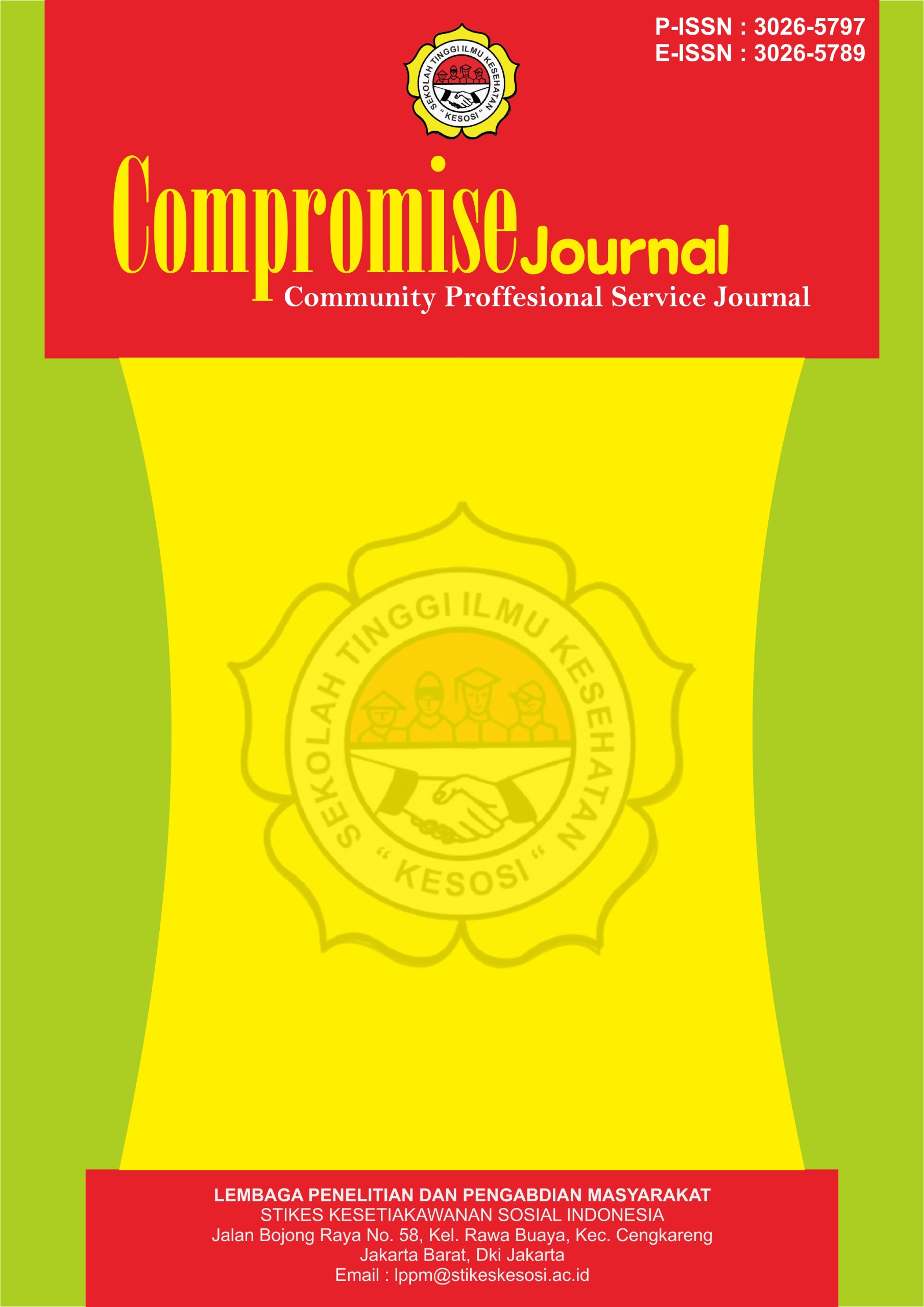Penyuluhan Kesehatan dan Pemeriksaan Kadar Asam Urat pada Masyarakat di Jungsereh Garut
DOI:
https://doi.org/10.57213/compromisejournal.v2i3.307Keywords:
uric acid, gout, screeningAbstract
Hyperuricemia is defined as increased levels of uric acid in the blood, this can result in gout which is characterized by pain and redness in the joints. Currently, increased uric acid levels are often caused by excessive consumption of red meat including offal, being overweight, consuming foods high in cholesterol, and rarely exercising. The purpose of this counseling and examination of uric acid levels is to increase public knowledge about gout and gout screening by conducting uric acid examinations using POCT. The implementation method used is direct delivery of material related to gout, symptoms, and prevention including screening of uric acid examinations using the POCT method.
References
Cha, Y., Lee, J., Choy, W., Lee, J. S., Lee, H. H., & Chae, D. S. (2024). Pathophysiology and Treatment of Gout Arthritis; including Gout Arthritis of Hip Joint: A Literature Review. Hip and Pelvis, 36(1), 1–11. https://doi.org/10.5371/hp.2024.36.1.1
Dewi, R. U. M. (2022). Pengaruh Mengkonsumsi Jus Sirsak terhadap Penurunan Kadar Asam Urat Pada Lansia di Kelurahan Pakuwon Garut Kota. Journal Medika Cendikia. http://repository.lp4mstikeskhg.org/94/1/MANUSCRIFT KTI.pdf
Engel, B., Just, J., Bleckwenn, M., & Weckbecker, K. (2017). Treatment options for gout. Deutsches Arzteblatt International, 114(13), 215–222. https://doi.org/10.3238/arztebl.2017.0215
Fernando, A., Rednam, M., Gujarathi, R., & Widrich, J. (2024). Gout. StatPearls. https://www.ncbi.nlm.nih.gov/books/NBK546606/
George, C., Leslie, W. S., & Minter, A. D. (2023). Hyperuricemia. In NCBI. StatPearls. https://www.ncbi.nlm.nih.gov/books/NBK459218/
He, Q., Mok, T. N., Sin, T. H., Yin, J., Li, S., Yin, Y., Ming, W. K., & Feng, B. (2023). Global, Regional, and National Prevalence of Gout From 1990 to 2019: Age-Period-Cohort Analysis With Future Burden Prediction. JMIR Public Health and Surveillance, 9, 1–19. https://doi.org/10.2196/45943
Herlina, J. S., & Tinungki, Y. L. (2023). Monograf Asam Urat di Perbatasan Kepulauan Indonesia-Filipina. PT. Sonpedia Publishing Indonesia. https://www.google.co.id/books/edition/Monograf_Asam_Urat_di_Perbatasan_Kepulau/w-XMEAAAQBAJ?hl=id&gbpv=0
Li, L., Zhang, Y., & Zeng, C. (2020). Update on the epidemiology, genetics, and therapeutic options of hyperuricemia. American Journal of Translational Research, 12(7), 3167–3181.
Singh, J. A., & Gaffo, A. (2020). Gout epidemiology and comorbidities. Seminars in Arthritis and Rheumatism, 50(3), S11–S16. https://doi.org/10.1016/j.semarthrit.2020.04.008
Singh, J. A., Reddy, S. G., & Kundukulam, J. (2011). Risk factors for gout and prevention: A systematic review of the literature. Current Opinion in Rheumatology, 23(2), 192–202. https://doi.org/10.1097/BOR.0b013e3283438e13
Soeroso, J., & Algristian, H. (2011). Asam Urat. Penebar Plus. https://www.google.co.id/books/edition/Asam_Urat/fLtbCgAAQBAJ?hl=id&gbpv=1&dq=gejala+asam+urat&printsec=frontcover
Cha, Y., Lee, J., Choy, W., Lee, J. S., Lee, H. H., & Chae, D. S. (2024). Pathophysiology and Treatment of Gout Arthritis; including Gout Arthritis of Hip Joint: A Literature Review. Hip and Pelvis, 36(1), 1–11. https://doi.org/10.5371/hp.2024.36.1.1
Dewi, R. U. M. (2022). Pengaruh Mengkonsumsi Jus Sirsak terhadap Penurunan Kadar Asam Urat Pada Lansia di Kelurahan Pakuwon Garut Kota. Journal Medika Cendikia. http://repository.lp4mstikeskhg.org/94/1/MANUSCRIFT KTI.pdf
Engel, B., Just, J., Bleckwenn, M., & Weckbecker, K. (2017). Treatment options for gout. Deutsches Arzteblatt International, 114(13), 215–222. https://doi.org/10.3238/arztebl.2017.0215
Fernando, A., Rednam, M., Gujarathi, R., & Widrich, J. (2024). Gout. StatPearls. https://www.ncbi.nlm.nih.gov/books/NBK546606/
George, C., Leslie, W. S., & Minter, A. D. (2023). Hyperuricemia. In NCBI. StatPearls. https://www.ncbi.nlm.nih.gov/books/NBK459218/
He, Q., Mok, T. N., Sin, T. H., Yin, J., Li, S., Yin, Y., Ming, W. K., & Feng, B. (2023). Global, Regional, and National Prevalence of Gout From 1990 to 2019: Age-Period-Cohort Analysis With Future Burden Prediction. JMIR Public Health and Surveillance, 9, 1–19. https://doi.org/10.2196/45943
Herlina, J. S., & Tinungki, Y. L. (2023). Monograf Asam Urat di Perbatasan Kepulauan Indonesia-Filipina. PT. Sonpedia Publishing Indonesia. https://www.google.co.id/books/edition/Monograf_Asam_Urat_di_Perbatasan_Kepulau/w-XMEAAAQBAJ?hl=id&gbpv=0
Li, L., Zhang, Y., & Zeng, C. (2020). Update on the epidemiology, genetics, and therapeutic options of hyperuricemia. American Journal of Translational Research, 12(7), 3167–3181.
Singh, J. A., & Gaffo, A. (2020). Gout epidemiology and comorbidities. Seminars in Arthritis and Rheumatism, 50(3), S11–S16. https://doi.org/10.1016/j.semarthrit.2020.04.008
Singh, J. A., Reddy, S. G., & Kundukulam, J. (2011). Risk factors for gout and prevention: A systematic review of the literature. Current Opinion in Rheumatology, 23(2), 192–202. https://doi.org/10.1097/BOR.0b013e3283438e13
Soeroso, J., & Algristian, H. (2011). Asam Urat. Penebar Plus. https://www.google.co.id/books/edition/Asam_Urat/fLtbCgAAQBAJ?hl=id&gbpv=1&dq=gejala+asam+urat&printsec=frontcover
Downloads
Published
Issue
Section
License
Copyright (c) 2024 Compromise Journal : Community Proffesional Service Journal

This work is licensed under a Creative Commons Attribution-ShareAlike 4.0 International License.






